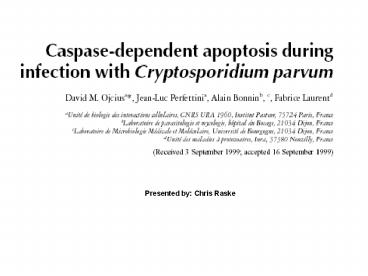Presented by: Chris Raske - PowerPoint PPT Presentation
Title:
Presented by: Chris Raske
Description:
Cryptosporidium generally infects the apical layer of endothelial cells of the ... that cell lysis occurs at these parasitophorous vacuoles at the apical membrane. ... – PowerPoint PPT presentation
Number of Views:51
Avg rating:3.0/5.0
Title: Presented by: Chris Raske
1
- Presented by Chris Raske
2
Cryptosporidium Parvum
- A protozoan parasite which belongs to the class
Coccidia. - Undergoes a complex life cycle with alternating
asexual and sexual reproductive cycles. - It is one of the most common non-viral causes of
diarrhea in many animals as well as humans. - The first reported human cases were in 1976, and
continues to infect people worldwide. In 1993
there was an outbreak in Milwaukee which infected
over 400,000 people.
3
Life Cycle
4
Cryptosporidium Parvum
- In immunocompetent individuals cryptosporidium
causes transient diarrhea, however in
immunosuppressed individuals, infection results
in more persistent and severe diarrhea which can
be fatal. (ex. AIDS) - Cryptosporidium generally infects the apical
layer of endothelial cells of the intestine, and
normally does not invade deeper layers of the
gastrointestinal mucosa. - Upon infection, the epithelial cells release
proinflamitory cytokines including neutrophil
chemoattractants, which are at least partly
responsible in attracting effector cells.
5
Cryptosporidium Parvum
- Mice deficient in B cells are able to fully
eliminate the parasite which suggests antibodies
are not required for its elimination. - However, SCID mice and mice unable to make MHC
class II molecules are susceptible to infection
by C. parvum. - These results suggest that cell-mediated immunity
is the most important factor in recovering from
C. parvum infection.
6
Infection Leads to Cell Lysis
- After excystation in the intestine, the parasite
invades epithelial cells where it remains in a
parasitophorous vacuole (PV) directly beneath the
apical membrane of the cell. - It has been shown that cell lysis occurs at these
parasitophorous vacuoles at the apical membrane. - However, the mechanism of cell death was
previously unknown.
7
Researchers Objective
- Are the cells undergoing cell death through
apoptotic pathways or necrosis? - DNA condensation?
- DNA fragmentation?
- If it is an apoptotic pathway, what are the
molecular mediators? Could a caspase inhibitor
alter cryptosporidiums pathology?
8
Apoptotic DNA Condensation and Fragmentation
- During Apoptosis, the cell cycle arrests and DNA
remains in a condensed form. - Apoptotic DNA fragmentation is a result of
caspase dependent pathways. - Caspase-activated DNA fragmenting factor (CAD) is
activated when it is cleaved by caspases and
released from its inhibitor (ICAD). - Upon activation CAD enters the nucleus and
degrades DNA
9
Caspase Inhibitors
- In a previous study researchers induced apoptosis
in liver cells with Antibodies against Fas, then
inhibited the apoptosis pathway with a caspase
inhibitor.
10
Apoptosis
11
Results
Apoptotic nuclear condensation during infection
Both the number of cells infected and the number
of apoptotic cells increased with higher
concentrations of oocysts.
Methods Cytofluorimetry PI staining
12
Results
Morphology of infected cells
DAPI staining to observe chromatin condensation
(A) HCT-8 cells without C. parvum
(B) HCT-8 cells with C. parvum
13
Results
DNA Fragmentation
There is considerable DNA fragmentation when
approximately 20 of cells are infected.
However, in the presence of a caspase inhibitor
(zVAD) the amount of fragmentation is decreased.
14
Results
Z-VAD effect on nuclear condensation of infected
cells
zVAD inhibited most of the DNA condensation,
however its presence increased the of infected
cells.
15
Conclusions
- C. parvums infection of epithelial cells does
induce apoptosis. Both DNA condensation and
fragmentation were observed shortly after
infection. - DNA condensation and fragmentation were inhibited
with a caspase inhibitor (z-VAD-fmk), which
suggests a caspase dependent pathway. In addition
the caspase inhibitor increased the percentage of
infected cells.
16
Future Studies
- A previous study showed C. parvum also caused
apoptosis in an infected biliary epithelial cell
line. Does C. parvum cause apoptosis in all
epithelial cells and what is the exact mechanism? - Intrinsic or extrinsic pathway or both?
- What are the consequences of inhibiting apoptosis
in these epithelial cells in vivo? - Does it benefit the host or the pathogen?
- During C. parvum infection the disruption of the
intestinal barrier allows absorption of large
molecules including lactulose and mannitol
leading to more severe diarrhea. - Could apoptosis be contributing to this increased
permeability?































